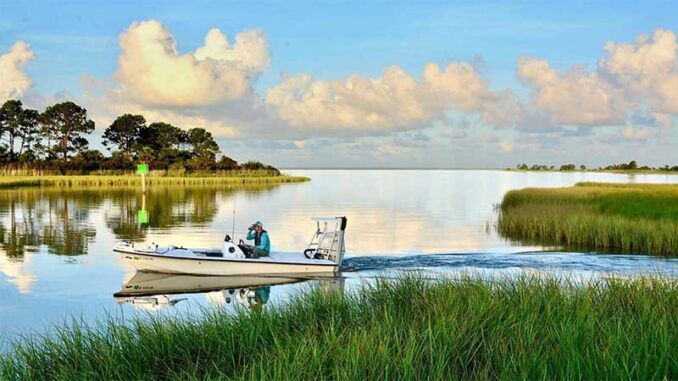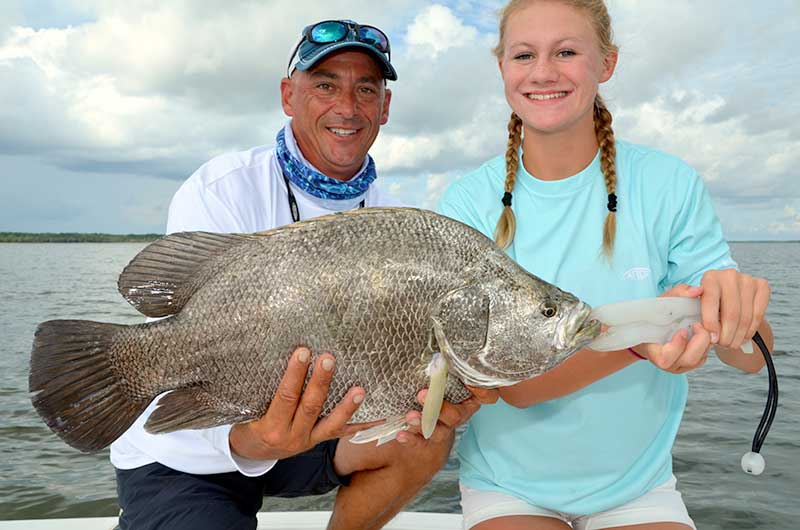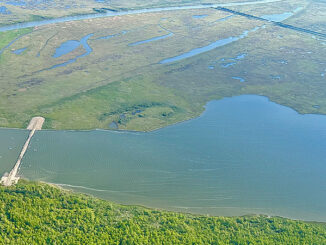
Called the “Forgotten Coast,” the part of the Florida Panhandle between Port St. Joe and Apalachicola gets overshadowed by other destinations in the Sunshine State. Some people call it “Old Florida” because much of it still looks like it did years ago.
Like the Mississippi River, but on a much smaller scale, the Apalachicola River pours into Apalachicola Bay and creates a rich marshy delta. The bay system also includes St. George Sound, St. Vincent Sound and East Bay. Indian Pass flows between the mainland and St. Vincent Island, connecting St. Vincent Sound to the Gulf of Mexico.
Finding tripletail
Tripletail move into the area from late April through October. In many ways, fishing for tripletail more resembles hunting. First, people must find them. Nobody knows when or where these unpredictable fish might materialize. They drift along with floating debris or hover near buoys, crab trap markers and other objects.
“Fishing for tripletail is more about finding them than catching them,” said Dan Van Treese (850-227-5149, www.perfectcastcharters.com) of Perfect Cast Charters. “Not every floating object will have a tripletail on it. When we’re out fishing or running, we always keep our eyes open for tripletail.”
Most anglers use live or fresh shrimp, crab pieces or other natural baits. While tripletail prefer natural baits, they sometimes hit artificial temptations such as plastic shrimp, minnow or crab imitations. Scented baits like Gulp! typically attract more attention than ordinary plastics.
Like in Louisiana, the Apalachicola River Delta marshes and bayous hold flounder and redfish. A gold spoon works on reds. Redfish and big black drum also stay near the reefs in the bay. In the summer, some people wade the beaches casting for speckled trout, redfish, Spanish mackerel, flounder, whiting, pompano and other species.
“For flounder, I use a ¼-ounce jighead with a soft-plastic paddled tail bait,” Van Treese said. “The tail color depends upon the water clarity. In very dark water, I use a root beer color. In clean water, I like white or silver. In the fall, big schools of bull reds go up and down the beaches.”
Targeting tarpon
Many anglers also fish the gulf beaches for tarpon and sharks. From late April through October, large pogie schools migrate along the coastline. Tarpon and sharks follow the baitfish schools. Anglers often cruise the coast looking for baitfish concentrations or tarpon rolling on the surface.

“Tarpon are keeping up with the bait so we have to keep up with their movements,” Van Treese said. “When we see tarpon actively feeding on pogies or rolling in the water, we know we’re in the right spot. Our best months for tarpon are May, June and July.”
When fishing for tarpon, anglers regularly catch lemon, bull, Atlantic sharpnose, blacktip and spinner sharks. Sometimes, anglers hook into a huge tiger or hammerhead. Besides sharks and tarpon, anglers might also catch king mackerel, Spanish mackerel, cobia and other fish along the beaches.
For tarpon and sharks, Van Treese uses live or fresh pogies. He uses 65-pound braid with a 60-pound fluorocarbon leader and a 7/0 circle hook. Sometimes, he throws swimbaits five to seven inches long at feeding tarpon.
“We free-line live bait,” Van Treese said. “Usually, we drift with the tide or slowly reel them back to the boat. We hook dead pogies through the chin and nose. We cast them and slowly reel them so they spin a little in the water. That makes them look like dying baitfish.”
After fishing, sportsmen might try something different. During scalloping season, people snorkel through shallow waters to catch these succulent morsels by hand. Although related to oysters, bay scallops scoot along by expelling water jets from their shells. Many restaurants will cook the scallops or fish that people catch that day.
While in the area
Louisiana visitors might enjoy attending the annual Florida Seafood Festival in the town of Apalachicola. See www.floridaseafoodfestival.com. Take a stroll down the River Walk. The world-famous Indian Pass Raw Bar (indianpassrawbar.com) at the Indian Pass Trading Post sits on the way to the Indian Pass boat launch.
Visitors can find lodging at the family-owned Turtle Beach Inn & Cottages (www.turtlebeachinn.com) with its own gulf beach. People can also stay at the T. H. Stone Memorial St. Joseph Peninsula State Park (www.floridastateparks.org) on Cape San Blas. The park has nearly 10 miles of superb beaches. Visitors can find more accommodations in Port St. Joe or Apalachicola.
Anglers hiring licensed captains do not need to buy a Florida fishing license. For seasons, limits and other regulations, see myfwc.com. For area information, see www.floridasforgottencoast.com.


